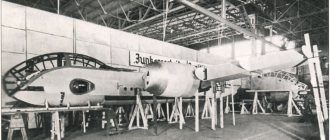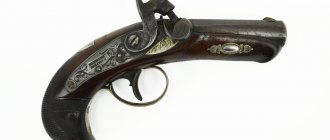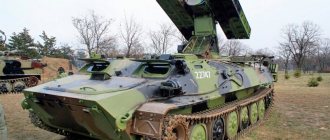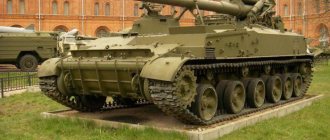| GAZ-46 MAV | |
| Total information | |
| Manufacturer | GAS |
| Years of production | 1953—1958 |
| Class | Amphibian |
| Design | |
| Layout | 4×4 |
| Engine | |
| 4-cylinder, displacement - 2111 cm³, power - 55 hp. at 2800 rpm | |
| Transmission | |
| mechanical | |
| Weight and dimensions characteristics | |
| Length | 4930 mm |
| Width | 1900 mm |
| Height | 1770 mm |
| Weight | 1270 kg |
| Dynamic characteristics | |
| Maximum speed | 90 km/h (afloat - 9 km/h) |
| Other information | |
| Load capacity | 0.5 tons |
| Media files on Wikimedia Commons | |
GAZ-46
is a floating car, produced by the Gorky Automobile Plant since 1953.
The military designation of the vehicle is “ MAV”
"(small waterfowl vehicle). The MAV vehicle is designed to support the operations of reconnaissance units, as well as to carry out engineering work on the water.
The history of the basis - a waterfowl amphibian from Ferdinand Porsche
Now let’s leave aside the post-war transformations of captured equipment and talk in more detail about the German “Schwimwagen”.
He can be considered the pioneer of amphibians, vehicles equally adapted to travel on both land and water. The Germans became pioneers here too, ahead of their closest competitors (the Americans) in this area by several years.
Why “and here”? Let us recall the developments of German designers in the field of rocket technology, the world's first jet-powered aircraft, and other achievements in the field of aviation. The list is long and interesting
Something else is important. Innovations in the field of weapons that appeared and were introduced during the Second World War did not save the Wehrmacht from defeat in 1945
Let's return to the Schwimmwagen. Its appearance became relevant after the failure of the blitzkrieg of 1941 on the Eastern Front, when the motorized divisions of the Wehrmacht were hopelessly bogged down not only in the fierce and bloody resistance of parts of the Red Army, but also in the famous impassable Russian mud, known since the time of Napoleon.
The Germans urgently needed an all-wheel drive off-road vehicle suitable for combat operations. The task is to replace motorcycles with sidecars, which were in service with reconnaissance and motorcycle battalions, since they turned out to be of little use in the off-road conditions of the Eastern Front.
For a year and a half, from the autumn of 1942 to the summer of 1944, the F. Porsche KG company produced more than 14,000 copies of this nimble and unpretentious car. Outwardly, she looked unusual, futuristic in her own way. Porsche was not only a brilliant inventor, but also something of a great technical artist. Everything his hand touched left its mark.
Look at this interesting little motor on the stern of his amphibian. It was fastened to the body with a strap, which released the unit, and it was immersed in the water using a long metal pin. The car was distinctive and recognizable, as evidenced by the archival photos of our gallery. The vehicle was used both as a communications vehicle and as a command vehicle, and was part of motorized units to support infantry.
But her main trump card was overcoming water obstacles. Actually, the machine was designed for these purposes. From open data, including Wikipedia, it is known that the VW Typ 166 was built on the basis of the world famous Volkswagen Käfer, better known as the Volkswagen “Beetle”. Ferdinand Porsche, together with the Austrian Erwin Komenda, turned the Beetle into a boat.
Watch this unique video. It shows rare archival film footage, apparently filmed during sea trials of the Schwimwagen. How quickly this modified Beetle moves on land. And how - by water. It can be seen that, thanks to the “boat” design, the amphibian’s nose works like a stand-up boat, instantly floating up after diving.
And the cross-country ability: how easily a vehicle weighing about one and a half tons, fully equipped, can enter and, more importantly, exit onto a steep bank with a gradient of 45°. This was achieved thanks to a specially created front-wheel drive transmission, paired with a reduction gear.
Air-cooled 4-cylinder boxer engine with a displacement of 1.1 liters and a power of 25 hp. With. developed a maximum speed of 80 km/h on land, and as much as 10 km/h on water. The amphibian's cruising range on the road reached 520 km.
The Americans did something similar in the middle of the war. Their amphibious Ford GPA rolled off the production line in 1942 and was supplied to the Soviet Union under the Lend-Lease program. In total, the Red Army received about 3 thousand units of such floating vehicles.
After the war, on the basis of this development, for which a license was acquired, the first Soviet amphibian was built: GAZ-46, which had the abbreviation “MAV”, that is, “small waterfowl vehicle”.
Kreshchuk's letter and its consequences
The indecisiveness of the enterprise management in determining further actions was suppressed by a letter sent by V.A. Kreshchuk personally to Stalin, in which he described in all details and colors the current situation with amphibians at the plant. In addition, do not forget to tell about the condition in which and with what documentation NAMI-011 arrived at GAZ. And also how much work it cost his group and him personally to finalize this machine, for which someone unfairly received a high reward.
The response to the letter was immediate. By a resolution of the USSR Council of Ministers, the Stalin Prize for the development of NAMI-011 was canceled, and those involved in the creation of “zero eleven” were punished. Of course, no radical methods were applied to them; measures of influence were limited to transfers from the capital to other cities to other enterprises with demotions.
M. Vorobyov, chief of the engineering troops, was removed from his position and transferred to a peripheral military district. Deputy Minister of MATP V. Garbuzov was sent to work at KhTZ as chief engineer. Lipgart went to UralZIS as an ordinary engineer. The head of GAZ, Vedenyapin, was sent to YaAZ to manage the engine shop, his place was taken by P. Lisnyak, who previously headed the KhTZ.
Kreshchuk himself, after personnel changes, took the post of deputy chief designer and headed a new bureau, which was supposed to deal exclusively with floating cars. But his career didn’t work out either. All the developments of his design bureau turned out to be unpromising. As a result, the bureau was disbanded, and Kreshchuk himself was completely fired in 1954.
But one way or another, no one canceled the task for the production of GAZ-011, and the plant had to implement it in full. In 1953, 68 vehicles were assembled and put into service in the SA. After which the production of the “eleventh” was closed, and the GAZ-46, which had cost so many people so much, was put on the production line.
NAMI-055 amphibian 1958
Amphibian NAMI-055
was created on the units of the all-wheel drive passenger car "Moskvich-410" and was equipped with a streamlined welded all-metal 4-seater body with a smooth bottom, all drive wheels on independent suspension, retractable into special niches, a rear propeller on a retractable column with a gearbox, a bilge pump and a spare wheel on the trunk lid. The first option was equipped with a 41-horsepower Moskvich engine with a cooling air intake from the body and an independent propeller drive from the intermediate shaft of the gearbox. Elastic elements (dampers) were introduced into the transmission, reducing high loads when the vehicle exits the water and reducing oscillations and vibrations afloat. The standard drive axles received swinging axle shafts and, using hydraulic cylinders, the suspensions were pulled into the side niches, and when moving afloat they were completely turned off.
photo of NAMI-055 on the water
This design made it possible to change the ground clearance
ranging from 80 to 300 mm. On land, the column with the rowing bridge was manually removed into the rear niche of the body. Thanks to the shallow draft (25 - 28 cm), the amphibian with a full load of 1560 kg on the water developed a fairly high speed - 12.3 km/h. The second version 055B used a 90-horsepower Tatra-603 (Tatra) V8 air-cooled engine, but the speed of the heavier vehicle afloat increased by only 2.2 km/h. Harsh realities have led scientists to the conclusion that increasing the speed of such machines only by increasing their power is impractical and the problem requires a different solution.
Description of the amphibian
The buoyancy of the waterfowl was ensured by a welded steel body on a frame made of box profiles. The chassis and transmission were from the GAZ-69, and the engine was from the Pobeda GAZ-M20 passenger car.
An additional shaft was installed in the transfer case for a propeller with three blades, protected from below from damage by a powerful arc. A reel of cables mounted on the steering column connected it to the water rudder, which was placed in the stream of water created by the propeller.
To increase cross-country ability on silted terrain, it was possible to lower the pressure in the tires without fear of water getting into the wheels. All electrical wiring is made with sealed electrical connectors; the ignition distributor does not require additional protection, since it is completely sealed.
A warning light was installed on the instrument panel to monitor the entry of water into the hold. A muffler and exhaust pipe are installed on the bow deck of the GAZ-46. True, the noise from the muffler was so strong that it unmasked the car. On the other side of the bow deck there is a gas tank filler, which means that if necessary, you can refuel the fuel tank directly on the water.
NAMI-011
The NAMI-011 prototype, naturally, was not assembled from scratch. The GAZ-67 acted as the domestic basis from which the main components and assemblies were borrowed, and in the body one could easily discern the features of an American waterfowl Ford.
But from the very beginning, the project was accompanied by constant difficulties. First of all, it was necessary to solve the problem of adapting the land chassis of a domestic jeep to the waterproof body of the future amphibian.
The power unit from the GAZ-67 also caused trouble. Since the car moved very slowly through the water, the engine was practically not blown by the oncoming air flow, and this led to its rapid overheating. The cooling system had to be redesigned. And in general, the specificity of the car required the creation of atypical components and assemblies: a propeller and its drive, a water rudder, and a bilge pump.
But the designers of the institute coped with the task assigned to them and almost met the deadline. In April 1949, two domestically produced amphibians under the marking NAMI-011 were prepared for testing.
The beginning of a difficult journey
With the onset of peacetime, the military’s desire to have a Soviet amphibian at its disposal did not disappear, and both vehicles, just like the Americans, - large and small. Therefore, Yuzhmash (at that time the Dnepropetrovsk Automobile Plant) began developing the BAS DAZ-485 - a large waterfowl vehicle. The order for the creation of a small machine (respectively MAV) was received by Muscovites, namely the NAMI Institute, which already had a lot of experimental developments behind it. Moreover, very little time was allocated for creating cars. Thus, having received an official order in June 1948, the finished vehicle was supposed to be presented for testing by March 1949. But the tight deadlines did not bother the institute’s designers, since, in fact, they needed to develop and assemble a couple of viable samples, without worrying too much about the difficulties of putting them into mass production.
The task was accepted. From that moment on, the path of the GAZ-46 began, the history of whose creation until the very end was accompanied by difficulties, conflicts, intrigues and destroyed quarries.
New life for an old amphibian
More than half a century has passed since the last car was released; most of the cars rusting in the backyards of military units were scrapped, but thanks to retro car lovers, some of them were given a new life.
Today's view notes the beauty of the case and its state of preservation. In any case, it takes little effort and time to restore it. But the engine is being changed to a more powerful one from the Volga GAZ 24/31. The 46th GAZ with a load weighs more than two and a half tons, and the M20 engine for it is already considered weak. True, to cool a modern gasoline engine, there is not enough air in the hold; a diesel engine works better in such conditions. The specialists leave behind the original manual transmission, transfer case, propeller, axles, capstan, pump for pumping out water and instruments (!). Although modern drivers no longer accept bridges without blocking, they are replacing them with military ones. It’s probably impossible to find wheels now either, so they are installed from a “distant relative” - an UAZ.
ZIM GAZ-12 Soviet representative 1948-1960
The Gorky Automobile Plant named after Molotov received instructions to begin developing a representative car at the beginning of 1948. The car was supposed to occupy an intermediate position between the middle-class GAZ-M20 Pobeda car and the ZiS-110 limousine. A car that received the factory index GAZ-12 ZIM
, had a very definite status - a car for the second echelon of the country's leadership.
In all basic parameters, it was supposed to be a step lower in class than the ZIS-110
, which was used by the top of the government.
No one doubted that ZiM Initially, a rather difficult task was set - it was necessary to design a body with a characteristic appearance and memorable “sleek” shapes.
photo of Cadillac Fleetwood 61 1948
The chief designer of the plant, Andrei Aleksandrovich Lipgart, came to the conclusion that the American sedan Cadillac Fleetwood 61
1948 release. And then - for the first time, by the way, in world practice - Lipgart decided to make a passenger car with three rows of seats without a frame, with a monocoque body. Only this design could provide acceptable mass and more or less “government” dynamics. The first two prototypes of the machine still did not satisfy Lipgart with their behavior. And only the third, with a front fascia copying Cadillac’s and bumpers stylistically similar to Buick’s, met the technical specifications.
photo GAZ-12 ZIM
The new Gorky machine was more advanced than the ZiS. Firstly, “ ZiM
” had a monocoque body, which for a long-wheelbase and heavy vehicle in those years was a bold, unparalleled solution that made it possible to lighten the structure by 200 kg at once.
Secondly, a hydraulic coupling was used for the first time on ZiM, which ensured exceptional smoothness. It was located between the engine
and the clutch and ensured good adaptability of the engine to road conditions.
Two cups (rotors) of the fluid coupling, not connected to each other, form a toroidal cavity filled with oil. The pump rotor is divided by bulkhead blades into 48 compartments, and the turbine rotor into 44. When the fluid coupling rotates, oil “harnesses” circulate in the compartments, which transmit torque from the pump rotor to the turbine rotor and at the same time allow their relative slippage. Although a fluid coupling does not increase engine torque like a torque converter with a hydromechanical transmission
, it allows you to start in second gear, provides quick and smooth acceleration, and allows you to drive in direct gear on roads with frequent inclines.
First gear is used only at the beginning of movement along a muddy country road or uphill. The Gorky Automobile Plant was the first to use the so-called flanged rear axle axle shafts on a Soviet car. Nowadays, they have received widespread recognition and have completely replaced the previous design, where the axle shaft was connected to the brake drum by a conical journal with a key. Another innovation introduced on the GAZ
-12 was wheels with 15-inch rims.
general information
Next, Ulyanovsk specialists were busy creating small off-road vehicles, which, however, they are still doing to this day. It would not be superfluous to add that the UAZ 69 is called a “goat”, but immediately after the cessation of production of the 69th model, they began to produce another model, not inferior in popularity, the UAZ 469, but the development was already carried out at the Ulyanovsk Automobile Plant.
Over the entire period, it was possible to create more than 600 thousand passenger off-road vehicles with the GAZ-69 index. This includes various modifications. Many car enthusiasts like the restoration of the GAZ 69. Debut tests took place under the supervision of the state commission in September 1951.
Thanks to its good cross-country ability and unpretentiousness, the model could become a standard for all world cars. Among the advantages of the GAZ-69 was the presence of a short wheelbase, low weight, an all-wheel drive system, and excellent ground clearance under the vehicle’s axles, which provided the pickup with the opportunity not to be afraid of difficult road conditions.
As the basis for a passenger car, specialists from the Gorky Automobile Plant decided to take the 67th model, which had proven itself well during the war and the first post-war years. As for the units and components of the new vehicle, they were borrowed from Pobeda, ZIM and the GAZ-51 truck.
Therefore, the model was distinguished by simply phenomenal production times. They took the power unit from the Pobeda and subjected it to minor modifications, resulting in 55 horsepower. The transmission of the new off-road vehicle was also borrowed from the famous GAZ-M-20.
As a novelty, the car had a new device that provided pre-heating. The interior was equipped with a heater, and warm air was provided for the front glass. Such improvements made it possible to use the Lawn at any time of year and in any weather.
The 67th model was created for army needs, but the Lawn-69 was intended for use by the national economy. The car was developed over 5 years (1948-1953), and its prototypes were called “hard worker”. The car was popularly called the “goat” because it jumped when driving over bumpy terrain and bumps, and also because of its short wheelbase and high seating position.
With such jumping ability, moving at high speed in a pickup truck was dangerous - there was a high probability of overturning. The production of the GAZ-69 car in an all-wheel drive version was mastered in two trim levels:
- A two-door body variation, which is equipped with wooden benches and can seat six people;
- A four-door body variation with seating for five people and a canvas roof.
The five-seater Lawn model, designated GAZ-69A, was popularly nicknamed “commander’s” or “chairman’s”, depending on the place where it was used - in the army or in agricultural areas. However, the car itself was clearly not a city car, however, there was no point in driving it on a city road.
The cross-country ability that the “goat” possessed served as the envy of many SUVs around the world - the 69th model with excellent dexterity overcame all kinds of fords and crawled out of the most impassable mud areas. The second half of the twentieth century made it possible to use the 69th model as a traveling vehicle for the military automobile inspection.
Many models received civilian execution at the Central Internal Affairs Directorate. The police received specially designed cars with a hard top. The latest modifications had the interior divided into 2 areas - the driver and the patrol policeman were in front, and offenders usually sat in the back.
Design of GAZ-46
Specifications:
- Length - 4.9 m; Height - 1.8 m; Width - 1.9 m; Wheelbase - 2.3 m; Wheel arrangement - 4x4; Ground clearance - 28 cm; Weight - 1.8 t; Power unit volume - 2,112 l; Power - 55 hp. at 3.6 thousand revolutions; Torque (max) - 125 Nm at 2 thousand revolutions; Maximum speed on land / afloat - 90 mph / 9 mph.
Body
To be able to move through water, the designers assembled a welded steel body on a box frame. For additional sealing, doors were excluded from his device. The body consisted of three parts, which were separated from each other by vertical partitions. The power unit and transmission system were located in the front compartment. Transport control elements and passenger seats were located in the central part. Cargo, spare parts and maintenance tools were placed in the rear compartment.
There was a wave breaker shield on the nose of the vehicle. The driver pulled it out before diving into the water. It was intended to protect against water getting into the engine cooling connectors and the cabin. It also helped eliminate the possibility of vehicles burying in the water. Additional devices included a bollard for towing a car through water and a capstan for a rescue buoy. The lever shock absorbers were extended outside the body. Spare wheels are placed in the rear.
Engine compartment and controls
A gasoline engine from the GAZ-20M, which had four cylinders, was responsible for moving the car. The designers took the suspension and transmission mechanisms from the GAZ-69. The power plant worked in conjunction with a mechanical gearbox. It had four stages: three front and one rear. A two-speed transfer case was also included in the design.
When switching to water, the motor was replaced by a three-blade propeller. The drive shaft, which was part of the transfer case design, was responsible for its operation. Instead of a standard steering mechanism, a water rudder was used to adjust direction on the water. He was in the stream of water that the propeller formed. Special wheels were developed for the GAZ-46 amphibian. The driver, driving off-road, could remotely reduce the tire pressure to increase cross-country ability.
Other nodes
The designers made all the wiring hermetically sealed, including the ignition distributor. No additional protection was required when overcoming water obstacles. To eliminate the possibility of flooding of the muffler and exhaust pipe, they were moved to the front. One of the main disadvantages was the strong noise from the muffler. In combat operations, he revealed the location of the vehicle. A successful design solution was the transfer of the fuel tank neck to the bow compartment. The crew could refuel the vehicle while afloat.
Salon
There was no beautiful design inside the body. Since the main customer was the army, the dashboard and related elements turned out to be simple, because their main task was to inform the driver about the state of the vehicle. The low level of comfort for the crew resulted from similar reasons. In appearance, the amphibian turned out to be similar to a boat. The dashboard was equipped with a speedometer, tachometer and an indicator of water penetration into the cabin.
The driver controlled the gearbox using levers located to his right. The pedals have an unusual shape. They were placed as close to each other as possible to fit into one hole (made to improve tightness). The windshield was attached to a folding frame. The crew raised it while traveling through water to protect against water getting inside the cabin. An awning could be installed to protect from precipitation. The crew was seated in five seats - two separate ones in front and a combined sofa in the back. The rear seats had no adjustment mechanisms. The fuel filter was moved to the cabin. This simplified the repair work.
Salon
Despite the fact that the interior of the GAZ-69A was considered quite free, it was not so comfortable to get into it, partly because of the narrow doors. It is clear that you won’t find an abundance of comfortable elements here, but everything you need is there.
On the front panel of the Lawn there is a minimum number of instruments, including a speedometer, an indicator that informs the driver about the level of remaining fuel in the tank, and an ammeter that shows the battery charge level. The transmission tunnel stands out very clearly on the floor, but, in principle, does not interfere much.
A large three-spoke steering wheel appears in front of him. To the right of the dashboard you can find the ignition key lock. The gearshift lever for a manual transmission comes out of the transmission tunnel itself.
Opposite the driver's seat, on the dashboard, there is a handle for holding on, because the car shook quite often, so it was simply necessary to hold on. The upper part of the doors was made of awning material, and the bottom was made entirely of metal.
During the cold season, a heating system was provided, which was sorely lacking in previous cars. And in the summer, a sun visor was provided. The luggage compartment lid is hinged. When it was in an open position, it made the trunk floor longer and made it possible to transport even oversized cargo.
The seats were covered with leatherette and, although they were soft, there was a drawback, which was the slippery material, so if there was an uneven road surface, it was quite difficult to sit on the chairs. The Lawn had a spring suspension design, thanks to which the car bounced on a bumpy road, and at the same time, everyone who was inside the car “jumped” along with it.
To ensure that the windshield was cleared of external contamination, a windshield wiper was installed, the trapezoid of which was mounted on top of the glass. In order to protect the vehicle interior from bad weather, the designers provided a covering, which was an awning made of dense material (tarpaulin) that does not get wet. The latter was pulled onto the GAZ 69 body frame, made of metal, using loops that were “soldered” along the edges of the covering and firmly fixed at the base.
Amphibious models
GAZ-46 was honored as number 100 to be included in the collection of models of the Russian scientific and educational magazine about Soviet cars “Autolegends of the USSR”. The publication, dedicated to one model, was published twice a month, and included a collector's replica car made in China at 1:43 scale by the Italian company DeAgostini. The declared circulation was 120 thousand copies. The dark green car is quite detailed in detail for such a scale, but experts say that the wheels in the model are not original, and the awning spoils the appearance. The model is disassembled into four parts: the body, the interior, the bottom and that same unsightly awning.
A model of the amphibian is being made in the same scale by the Ural Falcon workshop in Yekaterinburg, not only in green, but also in more decorative colors, for example, blue or red.
The GAZ-46 car was mass-produced until the end of 1958 and had no modifications; it remained in service for more than thirty years, although BRDMs were already used as reconnaissance vehicles. Amphibians were in service with pontoon-bridge regiments and airborne transport battalions not only in the Soviet Union, but also in the Warsaw Pact countries. It is not known how many cars are on the move today, but they exist, regularly transport caring owners on fishing or hunting trips and serve as a source of their rightful pride, and participate in displays of special equipment.
"Headache" of GAZ
Solving the problem with the production of NAMI/GAZ-011 became a real problem for GAZ management. The fact is that the Gorky residents were preparing a new GAZ-69 SUV for production, and the design of the vehicle’s components made it possible to use them for a waterfowl chassis (the factory workers already had plans to produce the MAV). But then suddenly they are forced to buy someone else’s car, which is also assembled from GAZ-67 components. And this required a return to the production of parts for the aging model, which was very irrational and would have slowed down work on the new SUV. In addition, the amphibian manufactured at the institute was assembled without taking into account the necessary requirements for mass production. And the design of NAMI-011 itself was very “crude” and required serious modifications, and the technical documentation accompanying the machines generally resembled “fiction.” However, the factory workers had no other choice but to accept the GAZ-011 project for work.
Floating car body
The GAZ-46 pontoon-type body is made without doors and is divided into three compartments by transverse partitions. The engine compartment is located in the bow compartment. The central compartment is the cabin for the crew and passengers, and at the rear there is a luggage compartment.
On the bow there is a reversible water deflector flap, which rises before entering the water. It prevents the nose from “burying” in the water, protects the air intake for engine cooling and the central compartment from water.
Between the headlights there is a bollard for mooring the amphibian on the water and a capstan for a rescue buoy.
Lever shock absorbers are installed outside the body. Spare wheels are stored on the rear upper platform.
Amphibian engine
Gorky residents used engines of the same family for the GAZ-46, which were produced at the plant after the Great Patriotic War. They are gasoline (fuel can be used even with an octane rating of 66), four-stroke carburetor, with a volume of 2.1 liters.
The M-20 and GAZ-69 engines are almost identical in design and overall dimensions. GAZ-69, 55 hp. pp., was more suitable for a waterfowl vehicle because it is equipped with an oil cooler, which does not require air blowing at high speeds, which are inevitable when moving in water.
The engine power from the Pobeda, which is the base one, is not much lower - 52 hp. With.
Since air access to the engine was limited, from the very beginning heat exchangers were provided in the sea water cooling circuit to cool the power plant.
The M20 engines were so reliable and wear-resistant that they still work on old cars. They are easy to maintain, maintain and repair, but the installation space in a narrow and deep compartment makes this advantage imperceptible in the GAZ-46.
Specifications
Power unit
The model was equipped with a 2.0-liter low-valve engine that produced 55 horsepower. The power unit was developed on the platform of the six-cylinder Lawn-11 engine, which was used on the famous GAZ-51 truck.
The installation itself has four large-diameter cylinders and operates on low-octane fuel (gasoline) A-66. The power plant was previously installed on the Pobeda car. The water pump had a massive metal fan impeller with 6 blades.
Suspension
As mentioned above, the suspension was a bit harsh due to the springs, because this was not a truck, but the model was not intended to be used in urban conditions and on a flat road. The off-road vehicle has a frame structure, and two axles along with the power unit were mounted on the frame.
All two axles are driven; there is no center differential. The frame is rectangular in shape and has six transverse reinforcements. The front axle can be equipped with Bendix-Weiss ball CV joints.
Steering
Despite the absence of a hydraulic power steering wheel in the structural component of the vehicle, it could be controlled without much difficulty, even if the pickup truck was stationary.
Brake system
It also did not have power brakes, so they can be called quite hard.
It is clear that drum brakes are installed on all wheels. Specifications
| dimensions | |
| Length | 3850 mm |
| Width | 1750 mm |
| Height | 2000 mm |
| Maximum speed | 90 km/h |
| Car weight | 1.5 tons |
| Wheelbase | 2300 mm |
| Front/rear wheel track | 1440 mm |
| Ground clearance | 21 cm. |
| Gas tank volume | 60 liters |
| Fuel consumption | 14 l/100 km |
| Engine | |
| Type | carburetor |
| Number of cylinders/location | 4 in one row/along the body |
| Cooling | liquid |
| Volume | 2.12 l |
| Compression ratio | 6.2 |
| Power | 55 l. With. |
| Cylinder operating order | 1/2/4/3 |
NAMI-055V amphibian 1959-1963
Successful tests were not the key to success: the amphibian turned out to be too complex and heavy, had poor maneuverability on the shore, and the process of its conversion was too long and labor-intensive, incompatible with military standards. The 055B vehicle did not have any development, but it became the first and only light military hydrofoil
. Abroad, its more advanced analogue appeared exactly 40 years later and at that time had nothing to do with military equipment.
The last work of the institute in the field of amphibious army vehicles in 1989 was the experimental low-profile multi-purpose rear-engine vehicle NAMI-0281
class 1.25 - 1.5 tons for the delivery of rapid response units, which was a combination of a light amphibian, a TPK and an armored personnel carrier. In its open displacement load-bearing body with short half-doors, a combat crew of eight people was placed on two longitudinal 4-seater seats with their backs facing each other. The driver's workplace was located in the center of the front part of the cabin; the power unit was located in the rear of the car. When the flat middle part of the windshield was folded down, the two triangular side sections folded in both directions. The main design innovations were an independent adjustable hydropneumatic suspension, which made it possible to change the ground clearance, a twin-shaft transfer case with power output to the propeller drive, and forced differential locking. On the highway, the car reached a speed of 125 km/h and looked more like an excursion and recreational BRDM than an effective combat vehicle.
Engine GAZ-12 ZIM
Basically it is a six-cylinder GAZ-11 engine
, the design of which was started by Gorky residents in 1937. Its production began in 1940, and it was used on GAZ-11-73 and GAZ-61 passenger cars, as well as on light tanks and self-propelled guns from the Great Patriotic War and GAZ-51 trucks. The power of 76 hp, which this engine developed in the “passenger” version, and even more so 70 hp. the cargo version (GAZ-51) was not enough for the GAZ-12. Therefore, the engine was boosted, increasing the power to 90 hp. at 3600 rpm. To do this, the compression ratio was increased to 6.7 units (fuel - gasoline with an octane number of at least 70). Actually, the ZiM was designed for 72-grade gasoline, but the car can run on 66-grade gasoline, and 76-grade gasoline is ideal for it.
Prerequisites for the occurrence
The experience of World War II showed the strengths and weaknesses of Soviet military equipment, as well as gaps in its creation. There were no floating cars in the army.
All-wheel drive four-wheeled Ford GPA amphibians and six-wheeled DUKW trucks received under Lend-Lease made it easier to cross rivers in Eastern Europe during the Soviet offensive against Nazi Germany.
Naturally, this technology was taken into account, and immediately after the war, both passenger and cargo amphibious vehicles were included in the long-term rearmament plan, along with other types.
First of all, the military was interested in a light command vehicle capable of crossing water obstacles and moving in the same group with armored vehicles.
The DUKW cargo truck became the first prototype of the ZIS-485, a large waterfowl vehicle (BAV). Over time, the GAZ-46 MAV, a small aquatic vehicle, became an analogue of the floating SUV Ford GPA.
The history of the creation of a floating car
The military was so interested in such types of equipment that already in 1948, the Scientific Automotive Institute (NAMI), on behalf of the Council of Ministers and the Ministry of Automobile and Tractor Industry, began developing an amphibian based on the mastered platform of the GAZ-67 SUV. The terms of reference spoke about equipment designed to transport by land and water a crew and sabotage groups of six people or 500 kg of cargo, and tow light trailers, pontoons and other watercraft used by engineering troops on water.
The first models were called NAMI-011, passed interdepartmental tests and were recommended for adoption by the troops, despite the fact that the design was crude.
The production of the amphibian was entrusted to the Gorky residents. The plant's specialists made many changes to the design, improving the characteristics of the vehicle as far as the mechanics of the GAZ-67 allowed.
From 1951 to 1953, pilot batches began to arrive to the troops under the name GAZ-011 and satisfied the military so much that serious difficulties arose in the development and implementation of the improved GAZ-46 vehicle, in which comments on the previous model were taken into account and most of its shortcomings were eliminated.
Serious intrigues wove, heads rolled, management changed, but in the end, a new car based on the more modern GAZ-69 saw the light of day.
Unfortunately, the amphibian was not produced for long, until the end of the fifties, because in the first post-war decades not only technology, but also combat tactics changed, and light amphibious vehicles were no longer needed. In addition, production of the basic GAZ-69 was transferred to the Ulyanovsk Automobile Plant, where amphibians could not be produced for purely production reasons.
Constructive kinship
It cannot be said that the GAZ-46 was radically different from the GAZ-011 - the GAZ-67B and GAZ-69 platforms retained a noticeable structural relationship. In addition, many of the solutions used in the creation of NAMI/GAZ-011 were obvious and the only possible ones, and therefore were used on the “forty-sixth”.
However, Grigory Wasserman, who headed the project until 1953, from the very beginning had a “donor” much more suitable for the amphibian and, in addition, had the opportunity to learn from the mistakes of his colleagues involved in the “011” project. In 1953, after personnel reforms at the Gorky Automobile Plant, the design bureau involved in the development of the GAZ-46 was headed by A. A. Smolin.
Like its predecessors, the buoyancy of the new amphibian was provided by a displacement pontoon-type hull without doors, welded from steel sheets, reinforced with “ties” and stringer frames and divided by transverse partitions into three compartments. In the front there was a 55-horsepower GAZ-69 engine. Its power was not much higher than the power of the GAZ-67 engine, but the combination with the “native” three-speed gearbox and transfer case with a range-shifter made it possible to use horsepower with much greater flexibility and efficiency.
In addition, the GAZ-69 engine “from birth” was equipped with an oil radiator, which was so necessary when driving in “water” mode, when the engine operated at high speeds and the radiator was deprived of oncoming air flow. However, for efficient engine cooling in conditions of limited air access, the water and oil cooling systems were supplemented with heat exchangers included in the seawater cooling circuit.
GAZ-46 was mass-produced until 1958. Since the production of the base GAZ-69 car moved to UAZ, it was planned to launch production of the GAZ-46 in Ulyanovsk, but for production reasons this was not possible.
Tactical tricks
Gorky residents greeted the ministry’s “proposal” without enthusiasm, supported by two “homemade products” and a heap of crude technical documentation. The fact is that the fundamental possibility of creating an amphibian based on the GAZ-67 at the Gorky Automobile Plant was considered back in 1944-1945, when one of the floating Fords arrived at the enterprise. And then the factory specialists came to the conclusion that this idea was completely unpromising.
The tricks that the “wizards” from NAMI resorted to during the creation of a couple of experimental samples required too much technological effort during mass industrial production. The GAZ designers calculated all this in advance and therefore were in no hurry to create an amphibian based on the “sixty-seventh”: a new model of the GAZ-69 passenger SUV was on the way - it was on its basis that the Gorky residents planned to build an amphibian.
And suddenly the ministry “slips” a project for development that essentially coincides with what the factory workers rejected five years ago. The production of MAV would require the continuation of the production of outdated GAZ-67 units, which seriously hampered the development of GAZ-69 production - this became a reason for dissatisfaction on the part of GAZ management.
In addition, the imposed project promised not only production, but also engineering problems. In addition to the fact that the design of NAMI-011 was “crude” in all respects, requiring significant improvements, the technical documentation transferred to the plant did not withstand any criticism precisely because of its “artistry”. The scientific institute simply did not have qualified specialists capable of properly drafting and processing the necessary documents, since when creating individual prototypes they were accustomed to being content with “technical impressionism.”
Be that as it may, the factory management could not refuse the ministry. In the fall of 1950, the GAZ-011 project was accepted for work, but the chief designer of the plant, A. A. Lipgart, with the support of the director of the enterprise, G. A. Vedenyapin, decided on a tactical ploy: the leading designer of the GAZ-69, Grigory Wasserman, received the go-ahead to create an amphibian based on which would be the platform of the “sixty-ninth”, and the work on fine-tuning NAMI-011, as expected, was included in the plan of the design and experimental department (DED), but for an indefinite period, along with other current affairs of the division.
Lipgart hoped that both models would be ready for production at the same time, and the customer would rightly choose the more advanced version. It cannot be said that the factory management sabotaged the work related to the transformation of the experimental NAMI-011 into serial GAZ-011, but they did not make any special efforts. Its leader, the previously unproven designer V. A. Kreshchuk (according to contemporaries, is not a very competent specialist, but is ambitious), had a completely different opinion about the significance of the project.
Today it is difficult to say what motivated this man in the events that followed: wounded pride and the desire to prove his importance at any cost or a sincere conviction that Lipgart was slowing down truly promising development. One way or another, Kreshchuk perceived the intensive work on creating the GAZ-46 amphibian based on the GAZ-69 SUV as an unauthorized encroachment on the “011” project.
Meanwhile, Lipgart “did not play along” to either side! Thus, to improve the hydrodynamics of the amphibian hull and improve the characteristics of the propeller, one of the leading Soviet specialists in this field, A. A. Smolin, was invited to the plant. At the same time, he also worked on the “46” project, but Smolin’s contribution to the improvement of NAMI-011 is difficult to underestimate. Thanks to his calculations and the adjustments made in accordance with them to the shape of the “pontoon” and the propeller architecture, the speed of the GAZ-011 afloat increased from 8 to 9 km/h.
A list of all the changes and improvements introduced by the designers of KZO GAZ into the development of NAMI would take a whole page. Innovations resulted in an extra half-centner of “live weight,” but tests of experimental models built at GAZ in May 1951 confirmed the correctness of the decisions made.
In June, small-scale production of the GAZ-011 began, and in the fall, the military conducted control tests of the modified amphibian and confirmed their readiness to take the vehicle into service. At the same time, the alternative GAZ-46 project, on which Wasserman’s group worked, was also approaching completion. In a word, until mid-autumn everything went according to Lipgart’s plans.
Faster, wider, stronger
If the first SUV GAZ-64 looked like a Willys, then the GAZ-69 is already very different in appearance from an American jeep. Firstly, it has become wider, which has a good impact on its resistance to rollover. Secondly, it looks a little more complicated due to a fairly large number of bent surfaces. The GAZ-69 does not seem like an overly utilitarian military vehicle; rather, it looks like a civilian hard worker who has been trained to work in difficult road conditions. This is partly true, because it borrowed some things from the Pobeda passenger car (for example, the gearbox). Let's go around it.
An attentive person will immediately pay attention to the inscription on the hood - UAZ. Indeed, since 1954, GAZ-69 was assembled in Ulyanovsk
Our car was produced in 1968, and if we take into account that after 1956 UAZ was engaged in independent production, and not just assembly, then we admit: the manufacturer of our GAZ is indicated correctly.
We will have to close our eyes to the alloy wheels and seats from a foreign car - the car is not in a museum, we had to change something in it. In addition to the wheels and seats, a connoisseur will immediately notice another alteration - the driver's door should be different. As standard, a spare wheel was installed behind the door, which in our case was moved to the rear side. This is where the alterations end, everything else here is as it should have been almost fifty years ago.
Hooks and supports on the hood are used when tilting the glass frame. This scheme was used quite widely, for example, on Dodge ¾. In this case, you can not only tilt the entire frame forward, but also raise the glass separately. For a car that, at best, offers a canvas top instead of a roof, and whose “stove” only blows on the glass, the ventilation is simply amazing.
There is a noticeable recess on the rear left fender: it was necessary for the already mentioned spare wheel. The arches on the doors are used to install the canvas roof. You can do this alone in about 10 minutes.
By and large, there is nothing more to see from the outside; let’s open the hood. The GAZ-69 is equipped with a GAZ-20 engine. It is worth telling about the history of this unit in a little more detail.
The only decent engine installed on Soviet cars until the end of the thirties was the M-1 engine, “rooted” in the power unit of the American Ford-A. Thus, by the beginning of the forties, the most popular domestic engine had a design almost twenty years ago. The situation had to be corrected somehow, so we purchased drawings of Dodge D5 engines from the 1937 model. Sometimes there is even an amount received by Americans for documentation - 25 thousand dollars.
The engine was redesigned quite significantly, first of all, the lubrication system and camshaft drive were changed (the Americans used a chain, but ours considered a gear transmission more reliable). Its volume became slightly smaller, but overall it remained the same Dodge. Nevertheless, the motor was now considered its own development and began to be actively used. In total, there are at least six of its variations: from our four-cylinder 52-horsepower GAZ-20 to the GAZ-203, a twin of two “sixes,” which was even installed on T-70 tanks.
The only significant difference between the GAZ-20 and its “donor” GAZ-11 (besides the smaller number of cylinders) was the piston stroke shortened by 10 mm. Accordingly, the motor has adopted almost all the advantages and disadvantages of its “big brother”. First of all, there is a fear of high speeds due to the use of steel-babbit liners. But with careful use it can last almost forever. The main thing is to switch to a higher gear in time and avoid long driving at high speed. We will now find out how this works out in practice.











